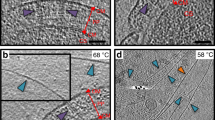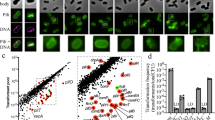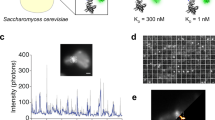Abstract
Bacteria use surface-exposed, proteinaceous fibers called pili for diverse behaviors, including horizontal gene transfer, surface sensing, motility, and pathogenicity. Visualization of these filamentous nanomachines and their activity in live cells has proven challenging, largely due to their small size. Here, we describe a broadly applicable method for labeling and imaging pili and other surface-exposed nanomachines in live cells. This technique uses a combination of genetics and maleimide-based click chemistry in which a cysteine substitution is made in the major pilin subunit for subsequent labeling with thiol-reactive maleimide dyes. Large maleimide-conjugated molecules can also be used to physically interfere with the dynamic activity of filamentous nanomachines. We describe parameters for selecting cysteine substitution positions, optimized labeling conditions for epifluorescence imaging of pilus fibers, and methods for impeding pilus activity. After cysteine knock-in strains have been generated, this protocol can be completed within 30 min to a few hours, depending on the species and the experiment of choice. Visualization of extracellular nanomachines such as pili using this approach can provide a more comprehensive understanding of the role played by these structures in distinct bacterial behaviors.
This is a preview of subscription content, access via your institution
Access options
Access Nature and 54 other Nature Portfolio journals
Get Nature+, our best-value online-access subscription
$29.99 / 30 days
cancel any time
Subscribe to this journal
Receive 12 print issues and online access
$259.00 per year
only $21.58 per issue
Buy this article
- Purchase on Springer Link
- Instant access to full article PDF
Prices may be subject to local taxes which are calculated during checkout





Similar content being viewed by others
Data availability
The data that support this study are available from the corresponding author upon reasonable request.
References
Green, E. R. & Mecsas, J. Bacterial secretion systems: an overview. in Virulence Mechanisms of Bacterial Pathogens 5th edn (eds Kudva, I. T. et al.) 215–239 (2016).
Kearns, D. B. A field guide to bacterial swarming motility. Nat. Rev. Microbiol. 8, 634–644 (2010).
Pelicic, V. et al. Type IV pili: e pluribus unum? Microbiology 68, 827–837 (2003).
Berry, J.-L. & Pelicic, V. Exceptionally widespread nanomachines composed of type IV pilins: the prokaryotic Swiss Army knives. FEMS Microbiol. Rev. 39, 134–154 (2015).
Blair, K. M., Turner, L., Winkelman, J. T., Berg, H. C. & Kearns, D. B. A molecular clutch disables flagella in the Bacillus subtilis biofilm. Science 320, 1636–1638 (2008).
Ellison, C. K. et al. Obstruction of pilus retraction stimulates bacterial surface sensing. Science 358, 535–538 (2017).
Paradis, G. et al. Variability in bacterial flagella re-growth patterns after breakage. Sci. Rep. 7, 1282 (2017).
Ellison, C. K. et al. Retraction of DNA-bound type IV competence pili initiates DNA uptake during natural transformation in Vibrio cholerae. Nat. Microbiol. 3, 773–780 (2018).
Berne, C. et al. Feedback regulation of Caulobacter crescentus holdfast synthesis by flagellum assembly via the holdfast inhibitor HfiA. Mol. Microbiol. 110, 219–238 (2018).
Cairns, L. S. et al. FlgN is required for flagellum-based motility by Bacillus subtilis. J. Bacteriol. 196, 2216–2226 (2014).
Turner, L., Stern, A. S. & Berg, H. C. Growth of flagellar filaments of Escherichia coli is independent of filament length. J. Bacteriol. 194, 2437–2442 (2012).
Dietrich, M., Mollenkopf, H., So, M. & Friedrich, A. Pilin regulation in the pilT mutant of Neisseria gonorrhoeae strain MS11. FEMS Microbiol. Lett. 296, 248–256 (2009).
Blocker, A., Komoriya, K. & Aizawa, S.-I. Type III secretion systems and bacterial flagella: insights into their function from structural similarities. Proc. Natl. Acad. Sci. USA 100, 3027–3030 (2003).
Craig, L. et al. Type IV pilus structure by cryo-electron microscopy and crystallography: implications for pilus assembly and functions. Mol. Cell 23, 651–662 (2006).
Chang, Y.-W. et al. Architecture of the type IVa pilus machine. Science 351, aad2001 (2016).
Wang, F. et al. Cryoelectron microscopy reconstructions of the Pseudomonas aeruginosa and Neisseria gonorrhoeae type IV pili at sub-nanometer resolution. Structure 25, 1423–1435.e4 (2017).
Mahmoud, K. K. & Koval, S. F. Characterization of type IV pili in the life cycle of the predator bacterium Bdellovibrio. Microbiology 156, 1040–1051 (2010).
Seitz, P. & Blokesch, M. DNA-uptake machinery of naturally competent Vibrio cholerae. Proc. Natl. Acad. Sci. USA 110, 17987–17992 (2013).
Imhaus, A.-F. & Duménil, G. The number of Neisseria meningitidis type IV pili determines host cell interaction. EMBO J. 33, 1767–1783 (2014).
Skerker, J. M. & Berg, H. C. Direct observation of extension and retraction of type IV pili. Proc. Natl. Acad. Sci. USA 98, 6901–6904 (2001).
Skerker, J. M. & Shapiro, L. Identification and cell cycle control of a novel pilus system in Caulobacter crescentus. EMBO J. 19, 3223–3234 (2000).
Bernard, C. S., Bordi, C., Termine, E., Filloux, A. & de Bentzmann, S. Organization and PprB-dependent control of the Pseudomonas aeruginosa tad Locus, involved in Flp pilus biology. J. Bacteriol. 191, 1961–1973 (2009).
Turner, L. & Berg, H. C. Labeling bacterial flagella with fluorescent dyes. Methods Mol. Biol. 1729, 71–76 (2018).
Giltner, C. L., Nguyen, Y. & Burrows, L. L. Type IV pilin proteins: versatile molecular modules. Microbiol. Mol. Biol. Rev. 76, 740–772 (2012).
Craig, L., Pique, M. E. & Tainer, J. A. Type IV pilus structure and bacterial pathogenicity. Nat. Rev. Microbiol. 2, 363–378 (2004).
Petersen, B. et al. A generic method for assignment of reliability scores applied to solvent accessibility predictions. BMC Struct. Biol. 9, 51 (2009).
Ng, D. et al. The Vibrio cholerae minor pilin TcpB initiates assembly and retraction of the toxin-coregulated pilus. PLOS Pathog. 12, e1006109 (2016).
Jones, C. J. et al. C-di-GMP regulates motile to sessile transition by modulating MshA pili biogenesis and near-surface motility behavior in Vibrio cholerae. PLoS Pathog. 11, e1005068 (2015).
Burrows, L. L. Twitching motility: type IV pili in action. Annu. Rev. Microbiol. 66, 493–520 (2012).
Marks, M. E. et al. The genetic basis of laboratory adaptation in Caulobacter crescentus. J. Bacteriol. 192, 3678–3688 (2010).
Miller, V. L., DiRita, V. J. & Mekalanos, J. J. Identification of toxS, a regulatory gene whose product enhances toxR-mediated activation of the cholera toxin promoter. J. Bacteriol. 171, 1288–1293 (1989).
Ried, J. L. & Collmer, A. An nptI-sacB-sacR cartridge for constructing directed, unmarked mutations in gram-negative bacteria by marker exchange-eviction mutagenesis. Gene 57, 239–246 (1987).
Dalia, A. B., McDonough, E. & Camilli, A. Multiplex genome editing by natural transformation. Proc. Natl. Acad. Sci. USA 111, 8937–8942 (2014).
Dalia, T. N. et al. Enhancing multiplex genome editing by natural transformation (MuGENT) via inactivation of ssDNA exonucleases. Nucleic Acids Res. 45, 7527–7537 (2017).
Dalia, A. B. Natural cotransformation and multiplex genome editing by natural transformation (MuGENT) of Vibrio cholerae. Methods Mol. Biol. 1839, 53–64 (2018).
POINDEXTER, J. S. Biological properties and classification of the Caulobacter group. Bacteriol. Rev. 28, 231–295 (1964).
Hepp, C. & Maier, B. Kinetics of DNA uptake during transformation provide evidence for a translocation ratchet mechanism. Proc. Natl. Acad. Sci. USA 113, 12467–12472 (2016).
Pönisch, W. et al. Pili mediated intercellular forces shape heterogeneous bacterial microcolonies prior to multicellular differentiation. Sci. Rep. 8, 16567 (2018).
Kelley, L. A., Mezulis, S., Yates, C. M., Wass, M. N. & Sternberg, M. J. E. The Phyre2 web portal for protein modeling, prediction and analysis. Nat. Protoc. 10, 845–858 (2015).
Craig, L. et al. Type IV pilin structure and assembly. Mol. Cell 11, 1139–1150 (2003).
Pettersen, E. F. et al. UCSF Chimera? A visualization system for exploratory research and analysis. J. Comput. Chem. 25, 1605–1612 (2004).
Acknowledgements
We thank M. D. Koch, A. M. Randich, and M. Jacq for critical feedback on the manuscript. This work was supported by grant R35GM122556 from the National Institutes of Health and by a Canada 150 Research Chair in Bacterial Cell Biology to Y.V.B., by grants R35GM12867 and AI118863 from the National Institutes of Health to A.B.D., and by National Science Foundation Fellowship 1342962 to C.K.E.
Author information
Authors and Affiliations
Contributions
C.K.E. and Y.V.B conceived the study. C.K.E. and T.N.D. performed the experiments. C.K.E., A.B.D., and Y.V.B. analyzed the data. C.K.E. wrote the manuscript with help from A.B.D. and Y.V.B.
Corresponding author
Ethics declarations
Competing interests
The authors declare no competing interests.
Additional information
Publisher’s note: Springer Nature remains neutral with regard to jurisdictional claims in published maps and institutional affiliations.
Related links
Key references using this protocol
Ellison, C. K. et al. Science 358, 535–538 (2017): http://science.sciencemag.org/content/358/6362/535
Ellison, C. K. et al. Nat. Microbiol. 3, 773–780 (2018): https://www.nature.com/articles/s41564-018-0174-y
Supplementary information
Rights and permissions
About this article
Cite this article
Ellison, C.K., Dalia, T.N., Dalia, A.B. et al. Real-time microscopy and physical perturbation of bacterial pili using maleimide-conjugated molecules. Nat Protoc 14, 1803–1819 (2019). https://doi.org/10.1038/s41596-019-0162-6
Received:
Accepted:
Published:
Issue Date:
DOI: https://doi.org/10.1038/s41596-019-0162-6
This article is cited by
-
Subcellular localization of type IV pili regulates bacterial multicellular development
Nature Communications (2022)
-
GGDEF domain as spatial on-switch for a phosphodiesterase by interaction with landmark protein HubP
npj Biofilms and Microbiomes (2022)
-
Acinetobacter baylyi regulates type IV pilus synthesis by employing two extension motors and a motor protein inhibitor
Nature Communications (2021)
-
Visualizing the dynamics of exported bacterial proteins with the chemogenetic fluorescent reporter FAST
Scientific Reports (2020)
-
A modular chromosomally integrated toolkit for ectopic gene expression in Vibrio cholerae
Scientific Reports (2020)
Comments
By submitting a comment you agree to abide by our Terms and Community Guidelines. If you find something abusive or that does not comply with our terms or guidelines please flag it as inappropriate.



